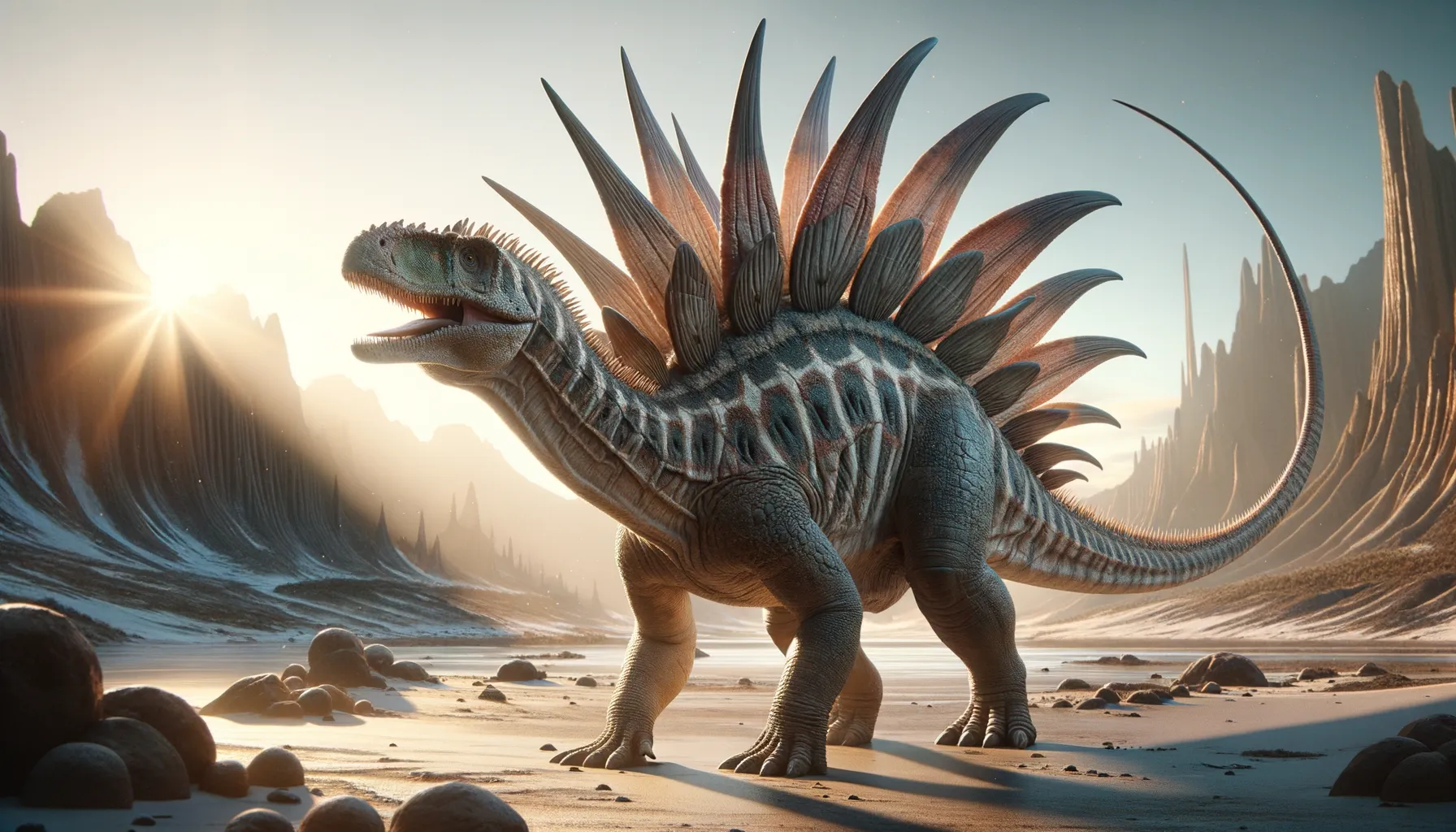
Huayangosaurus
Armor-plated herbivore from Jurassic China!
Period
Jurassic
Length
Measured approximately 4.5 meters in length.
Height
Stood about 1.5 meters tall at the hips.
Weight
Weighed around 500 kilograms.
Huayangosaurus was a small, early member of the stegosaur family, known for its distinctive array of plates and spikes along its back and tail. It lived during the Middle Jurassic period in what is now China. Equipped with sturdy limbs and a relatively small body, it is thought to have been a slow-moving herbivore. This dinosaur provides insight into the early evolution and diversity of stegosaurs.
Diet
Huayangosaurus was primarily an herbivore. Its diet consisted mostly of low-lying plants, including ferns and cycads. Its blunt teeth were well-suited for grinding vegetation.
Hunting
As a herbivore, Huayangosaurus did not hunt other animals. Instead, it spent its time foraging for plant material, using its strong beak for cropping vegetation. It was likely an opportunistic feeder, taking advantage of the vegetation available in its environment.
Environmental challenges
Huayangosaurus faced challenges such as fluctuating climates during the Jurassic period. It had to contend with predators like theropods, which required defensive adaptations. The shifting landscapes may have affected its feeding patterns, requiring it to frequently move in search of food. Additionally, competition with other herbivores for resources could have been a continuous struggle.
Speed
Moderately slow due to its bulky build.
Lifespan
Estimated to live up to 20-30 years.
First discovery
Discovered in the early 1980s in China.
Fun Facts
- Huayangosaurus lived during the Middle Jurassic period, around 165 million years ago.
- It was one of the earliest known members of the stegosaur family, a group of dinosaurs known for their distinctive plates and spikes.
- Huayangosaurus was named after the Huayang region in China where its fossils were first discovered.
- This dinosaur was relatively small compared to its more famous cousin, Stegosaurus, growing up to about 4.5 meters (15 feet) long.
- Unlike some of its larger relatives, Huayangosaurus had a shorter neck and a more robust body, making it look quite stocky.
- Its back was lined with two rows of bony plates, which likely helped protect it from predators.
- Huayangosaurus had a beak-like mouth that was perfect for cropping low vegetation, much like a modern-day lawnmower.
Growth and Development
Huayangosaurus is believed to have undergone a relatively rapid growth phase during its early years, similar to other dinosaurs. Juvenile stegosaurs likely had fewer and smaller plates and spikes, which developed more prominently as they matured. Fossil evidence suggests that its growth rates varied greatly, possibly due to differing environmental conditions and nutritional availability.
Habitat
Huayangosaurus lived in lush, forested regions with an abundance of ferns and cycads. These environments provided ample food supply and shelter from predators. It is thought to have favored lowland areas with access to water sources, such as rivers and lakes. The presence of various other plant-eating dinosaurs indicates a complex ecosystem within its habitat.
Interaction with other species
Huayangosaurus likely lived alongside various other herbivorous dinosaurs, competing for similar food sources. It might have formed herds for mutual protection against predators. The presence of large carnivores in its environment meant it had to be vigilant and rely on its spiked tail for defense. Fossils suggest that it shared its habitat with other stegosaurids, leading to possible interspecies interactions.
Natural lifespan
Huayangosaurus had a natural lifespan of approximately 20-30 years.
Reproduction
Like other stegosaurs, Huayangosaurus likely laid eggs. Fossil evidence suggests some stegosaurs might have buried their eggs for protection, though it remains speculative for Huayangosaurus. Nesting behaviors could have included guarding young, though direct evidence is lacking. Parental care, if present, would have been crucial for the survival of juveniles in a predator-rich environment.
Social behaviour
Huayangosaurus might have exhibited herd behavior as a strategy against predators. Living in groups could have provided greater vigilance and collective defense. Social interactions within herds would have included visual displays using their plates and spikes. However, the extent of such behavior in Huayangosaurus remains speculative based on related species.
Fossil locations
Fossils of Huayangosaurus have been predominantly found in the Sichuan Basin of China. These discoveries are primarily associated with the Dashanpu Formation, dating back to the Middle Jurassic period. The location of these fossils has provided valuable insights into the paleobiogeography of early stegosaurs. Ongoing excavations in the region continue to reveal new information about its lifestyle and environment.
